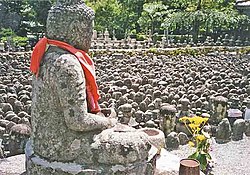Exhumation
Exhumation is the act of digging up, especially a corpse. This is most often done to relocate a body to a different burial spot.
Families may make this decision to locate the deceased in a more pertinent or convenient place. In shared family burial sites (e.g. a married couple), if the previously deceased person has been buried for an insufficient period of time the second body may be buried elsewhere until it is safe to move it to the requested grave.
In most jurisdictions a legal exhumation usually requires a court order or permission by the next of kin of the deceased. Also in many countries permits are required by some governing agency like the board of health in order to legally conduct a disinterment.[1]
Exhumation Media
Unearthed grave from the medieval Poulton Chapel
Reconstruction of the Mesolithic tomb of two women from Téviec, Brittany
A naturally mummified body in the British Museum
Zoroastrian Towers of Silence outside Yazd, Yazd province, Iran
Kanji inscriptions engraved on headstones in the Japanese Cemetery in Broome, Western Australia
Soldiers' dog cemetery at Edinburgh Castle
Exhumation of those killed in Bucha massacre in March 2022
Adashino Nembutsuji in Kyoto, Japan, stands on a site where Japanese people once abandoned the bodies of the dead without burial.
References
- ↑ Exhumation of the remains of a deceased person. Citizens Information Ireland. Retrieved on 29 June 2014.









